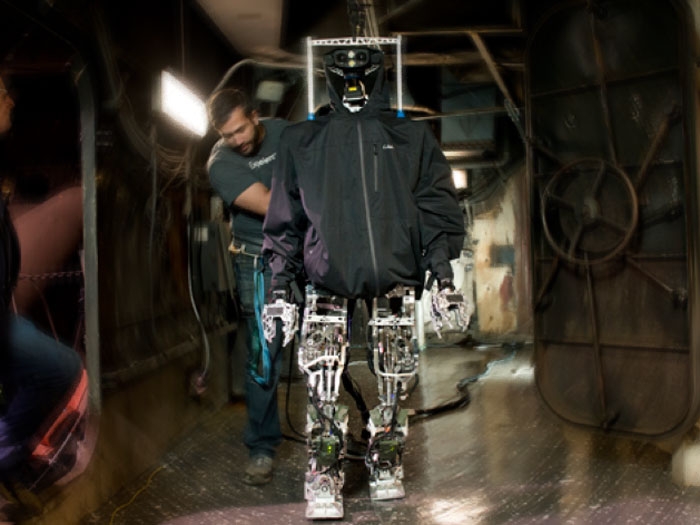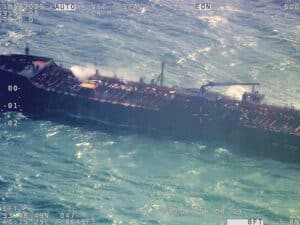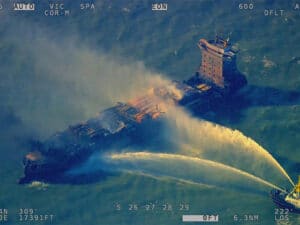
ONR unveils prototype robot firefighter
Written by Nick Blenkey
February 6, 2015 — In tests aboard a decommissioned Navy ship last fall, a humanoid robot located a live shipboard fire and sprayed it with water from a hose. Called SAFFiR (Shipboard Autonomous Firefighting Robot), the robot has been developed by researchers at Virginia Tech, sponsored by the Office of Naval Research (ONR).
The two-legged, or bipedal, robot stands 5 foot 10 inches tall and weighs about 140 pounds. Sensors, including infrared stereovision and a rotating laser for light detection and ranging (LIDAR), enable the humanoid to see through dense smoke. It is programmed to take measured steps and handle hoses on his own, but for now, takes instructions from researchers at a computer console.
ONR says the unique mechanism design on the robot equips it with super-human range of motion to maneuver in complex spaces.
In three days of tests aboard the the former USS Shadwell, the robot walked across uneven floors, used thermal imaging to identify overheated equipment, and used a hose to extinguish a small fire.
The demo, four years in the making, is part of a U.S. Navy effort to better assist sailors in fighting fires, controlling damage, and carrying out inspections aboard ships via user-controlled unmanned craft or humanoid robots.
“It’s not going to replace Navy firefighters, it’s going to assist Navy firefighters,” said Viktor Orekhov of Morristown, Tennessee, who graduated from Virginia Tech in December 2014 with a doctorate in mechanical engineering.
Orekhov is one of 15 engineering students in the college’s Terrestrial Robotics Engineering and Controls Lab (TREC) and the Extreme Environments, Robotics & Materials Laboratory (ExtReMe) who helped conceive, design, build, and test SAFFiR.
During a three-day demo in November 2014, students from the TREC and ExtReMe labs, along with faculty advisor Brian Lattimer, an associate professor with the Department of Mechanical Engineering, prepped SAFFiR for a fire suppression test onboard the former USS Shadwell, a decommissioned ship in Mobile, AL, that is now used as a damage control research center to test new shipboard firefighting techniques.
Along a narrow, low-hung hallway, SAFFiR was tasked — programmed by the labs’ imaging and manipulation team — to walk toward a sailor, stop, turn, locate the heat source of a fire behind a door, and (once the door opened) take a hose and blast the flames with water, all without falling or stopping.
Students spent many hours aboard the ship prepping for the demo and hundreds of hours before that in the lab designing, fabricating, and testing SAFFiR. Unlike animating movie robots with CGI, getting a real robot to walk upright is a challenge.
The Shadwell created extra obstacles: Heat from previous test fires has buckled its floors. In the hallway where SAFFiR walked, the floor slanted away from the path the robot has to take.
SAFFiR is, of course, a prototype, and the day of robot firefighters is long off.
“These robots can work closely with human firefighters without firefighters being directly exposed to steam or heat, fire and smoke,” Dr. Thomas McKenna, ONR program manager for human-robot interaction and cognitive neuroscience, said at the Shadwell demo.
Robots may one day patrol ships, he said, scanning for unnatural heat, smoke, or other issues and providing a “constant watch” against onboard dangers not detected by sailors.
The robot’s presence will be welcome. “Have you ever been on a ship that’s on fire? It’s terrifying,” said Dominique Pineiro, a Navy veteran on the Shadwell “That’s a fact.”
SAFFiR team members and the Navy unveiled the robot February 4, 2015, to media and the public at the Naval Future Force Science & Technology EXPO in Washington, D.C.
Future incarnations of SAFFiR already are planned with the Navy, according to Lattimer, with upgrades including improved movement. Funding from the Navy stands at $4.5 million and could increase as the project continues.
“We set out to build and demonstrate a humanoid capable of mobility aboard a ship, manipulating doors and fire hoses, and equipped with sensors to see and navigate through smoke,” said Dr. McKenna. “The long-term goal is to keep sailors from the danger of direct exposure to fire.”
Dr. McKenna says ONR plans to sponsor a more advanced design as part of the long-term investigational research program. Blueprints include equipping the robot with enhanced intelligence, communications capabilities, speed, computing power and battery life for extended applications.
“We have taken a look at other kinds of sensors that you can put on these robots,” he said. “For instance, a bipedal robot could be configured to take shipboard measurements, scan for corrosion and leaks, and identify changes to the shape of the room from its original configuration. By taking on these time-consuming tasks, SAFFiR could free up sailors for jobs that more fully take advantage of their training and technical skill sets.”
Even with added intelligence, however, SAFFiR will take its instruction from sailors and “fire bosses” working remotely in the event of a fire or other dangerous event.
“We’re working toward human-robot teams” Dr. McKenna said. “It’s what we call the hybrid force: humans and robots working together.”
ONR envisions a future — long off, but tangible — in which every ship has a robot as a tool for firefighters.





Leave a Reply
You must be logged in to post a comment.